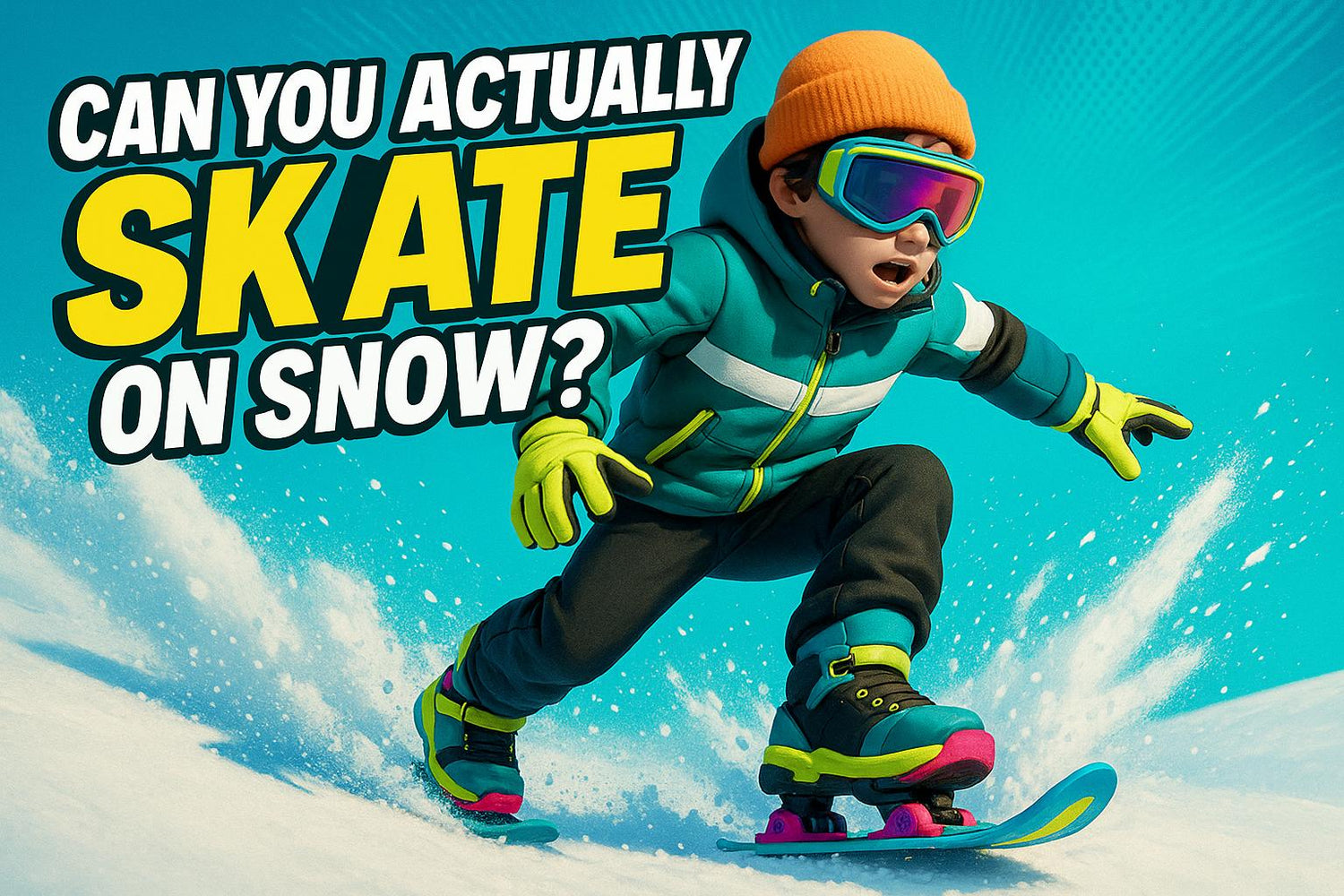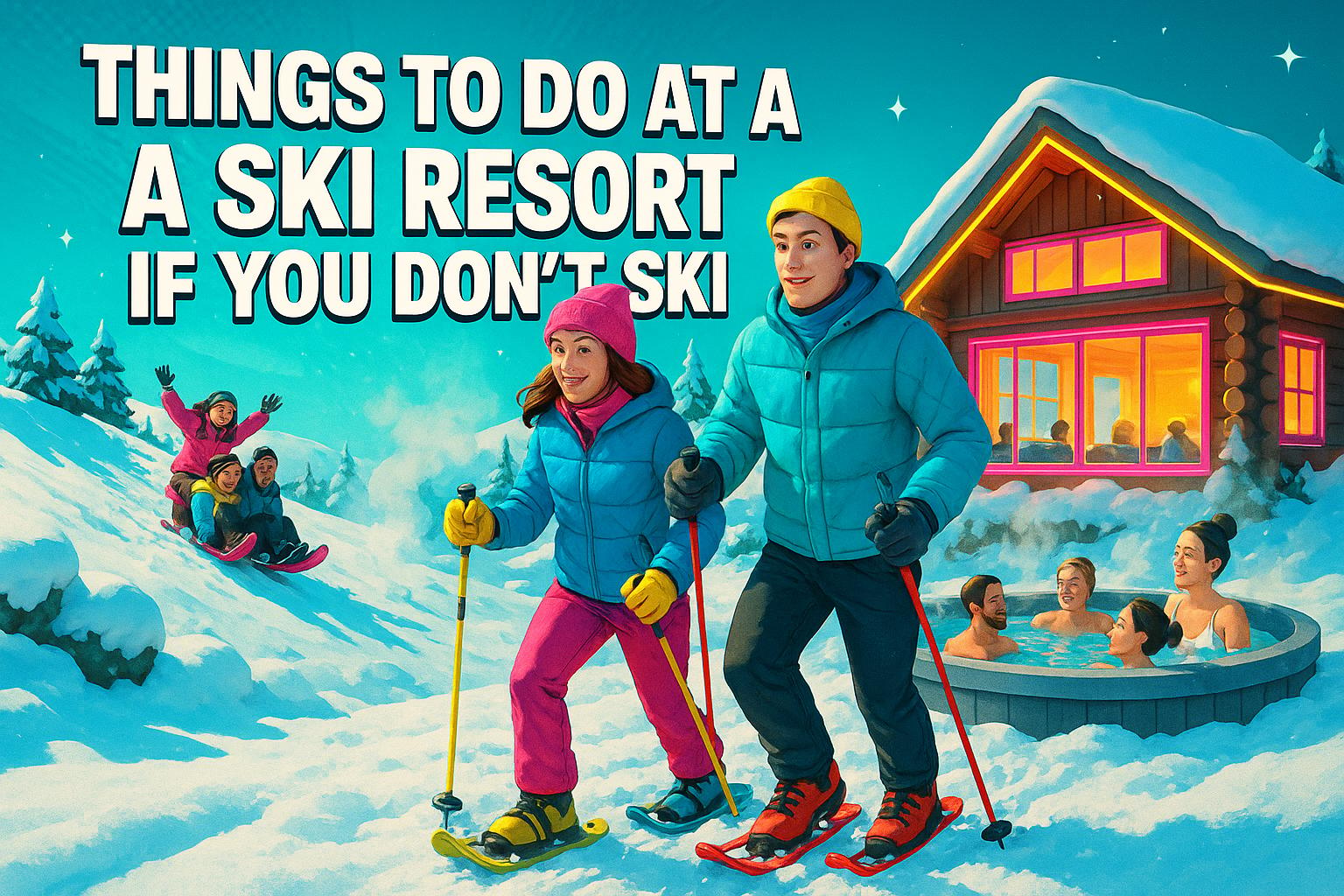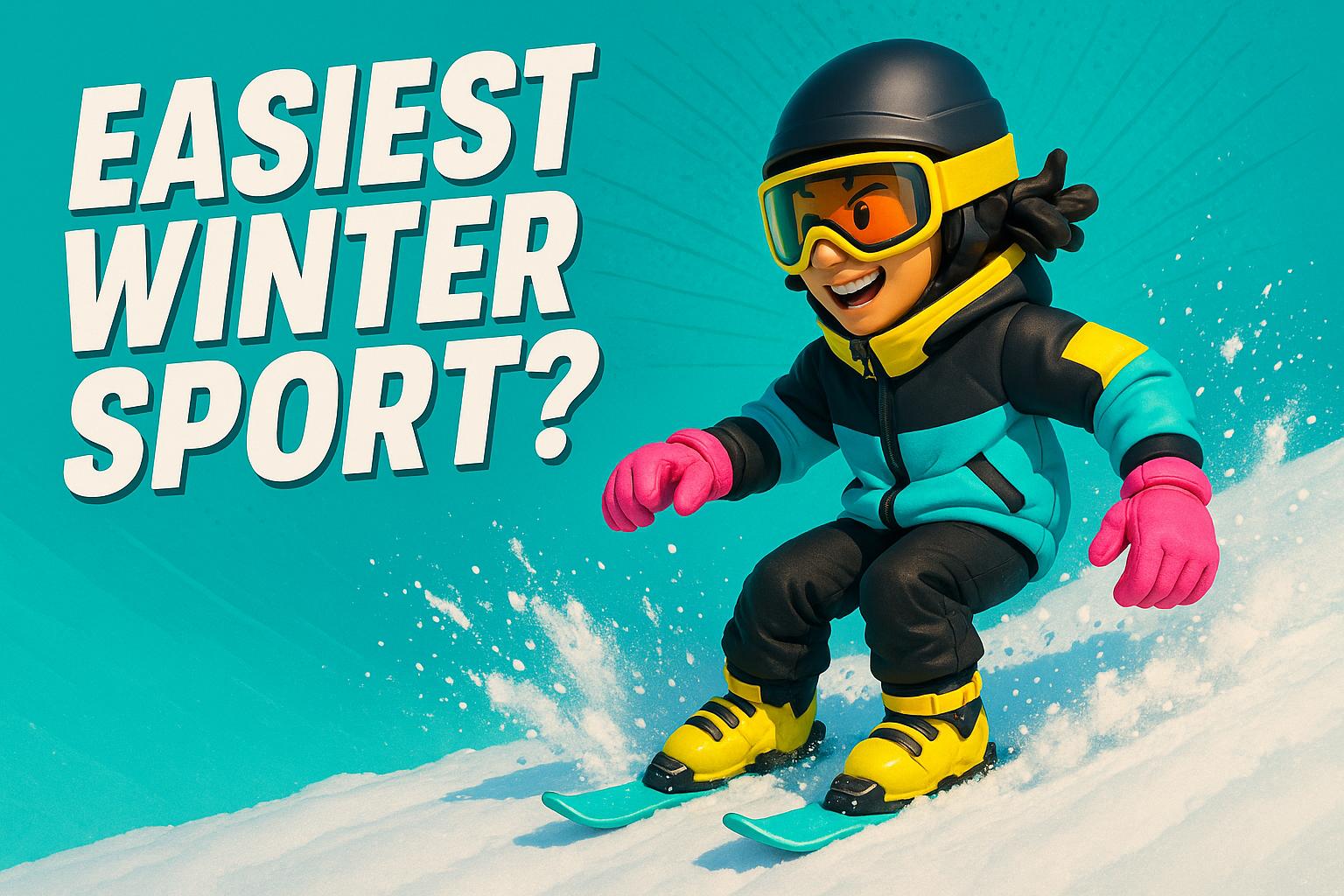Snow skatingはスキーとスケートを組み合わせた楽しい冬のアクティビティです。かさばるスキーの代わりに、冬用シューズやスノーボードブーツに装着するコンパクトなsnow skatesを使います。軽量で持ち運びやすく、習得も簡単です。知っておくべきことはこちら:
- Snow Skatesとは? 15〜20インチの小さなスキーで、スケートのような機敏さで雪上を滑ることができます。
- なぜSnow Skatingを試すのか? スキーよりも習得が簡単で、さまざまな地形で使え、重い装備が不要です。
-
人気のオプション:
- Mini Skis (38 cm): 初心者やカジュアルな使用に最適です。
- Skiskates (44 cm): 整備された斜面やトリックに最適です。
- PRO (50 cm): より厳しい地形での安定性を提供します。
- 費用:140ドルから始まり、伝統的なスキーセットアップよりずっと安価です。
簡単比較表:
| モデル | 長さ | 重量 | 最適用途 | ブーツ互換性 | 価格 |
|---|---|---|---|---|---|
| ミニスキー | 15 in | 最軽量 | 初心者、裏庭用 | 冬用シューズ | 140ドルから |
| Skiskates | 17.3 in | 3.5ポンド | 整備された斜面、トリック | スキー/スノーボードブーツ | 330ドルから |
| プロ | 19.7 in | 中級 | オールテレイン、上級者向け | 冬用シューズ/スノーボードブーツ | $230 |
Snow skatingは手頃で持ち運びやすく、初心者にも優しい—伝統的なスキーの面倒なしで冬のスポーツを楽しみたい人に最適です。
Snowfeet* & Skiskates 完全ガイド | Skiskatingについて知っておくべきことすべて
スノースケーティングの仕組み
Snowfeetのコンパクトなデザインは、雪上での滑走に新しいひねりをもたらし、伝統的なスキーとは全く異なる体験を提供します。これらのshort skisがどのように機能し、なぜ際立っているのかを分解してみましょう。
エッジコントロールとターン:迅速かつ正確
わずか44~50cmの長さのSnowfeetは、鋭く即座のエッジコントロールを提供します。このコンパクトなサイズは、よりタイトな半径での素早く正確なターンを可能にします。これは、HeadやElanのようなブランドの長いスキーで描く大きな弧ではなく、アイススケートのようなカービングに例えられます。接地面積が小さいため、ほぼ瞬時に方向を変えられ、応答性の高さは他に類を見ません。
体重配分:バランスを保つ
ここが伝統的なスキーと異なる点です。長いスキーのように前傾するのではなく、Snowfeetは体重を中央かやや後ろに保つのが最適です。この姿勢は前に倒れるのを防ぎ、装備がより自然で親しみやすく感じられます。さらに、バランスを保つことでコントロールが向上し、これらの短いスキーをマスターする鍵となります。
短いスキーの雪上でのパフォーマンス
短いスキーの敏捷性が際立つ特徴です。整備されたコースでは、スムーズに滑り、瞬時に方向転換が可能です。ただし、接地面積が小さいため、高速時には伝統的なスキーに比べて安定感がやや劣ることがあります。これはトレードオフで、操作性を得る代わりに、スピードを出すときに安定性が少し犠牲になるかもしれません。
硬い表面で最適
Snowfeetは圧雪された雪や整備されたトレイルで輝きます。その小さなサイズは、浮力が必要なパウダーでは長いスキーが優れるため、効果が薄くなります。しかし、硬い表面では非常に多用途で、かさばるスキーセットアップが実用的でない場所も探検できます。狭いトレイルやコンパクトな斜面など、伝統的なスキーが扱いにくい場所を想像してください。
簡単に学べる
Snowfeetの一番クールな点のひとつ?それは初心者に優しいことです。短い長さがターンやコントロールを直感的にし、管理する装備が少ないため、動きとスキーの反応の間にほぼ即座のつながりを感じられます。これにより、急な学習曲線なしで新しいことに挑戦したい人にとって素晴らしい選択肢となります。
Snowfeet製品ガイド
Snowfeetには、Rossignol、Atomic、またはHeadのようなブランドのかさばるギアと比べて、コンパクトで高性能な3つのモデルがあります。
Snowfeet Skiskates(44 cm)
Snowfeet Skiskatesは彼らの代表モデルです。わずか44cm(17.3インチ)、約1.6kg(3.5ポンド)のこれらのSkiskatesは、スキーのスリルとスケートの機敏さを兼ね備えています。放物線形状と狭いウエストのおかげで、シャープで反応の良いカービングが可能で、長いスキーでは到底真似できないタイトなターンを楽々と滑走できます。
ヨーロッパ製のこれらのSkiskatesは、持続可能な木材コア、金属エッジ、グラファイトベースを備え、耐久性とパフォーマンスを実現しています。ビンディングは調整可能で工具不要、スノーボードブーツとスキーブーツの両方に対応します。さらに、安全リーシュと滑り止め表面が付属し、安心感を高めています。
"私の意見では、Skiskatesはこれまでに開発した中で最高の斜面用製品です。スキーとスケートがどれほど簡単にできるか、そしてほとんど制限なく多くの種類のトリックを実行できることが大好きです。" - Zbyněk, Snowfeet創設者
フェニックスのPaul Agueさんは、彼のサイズ32.5のスキーブーツとSkiskatesが完璧に合い、ホッケー時代を思い出させるスケートのような体験を提供したと共有しました。アレクサンドリアのSammy Badillaさんはそれらを「素晴らしい」と「非常に操作しやすい」と評しました。124件のレビューで97%の高評価と完璧な5.0評価を誇り、その数字がすべてを物語っています。
もう少し安定感が欲しいですか?Snowfeet PROをチェックしてみてください。
Snowfeet PRO(50 cm)
Snowfeet PROは50cm(19.7インチ)で、コンパクトなデザインと安定性のバランスを実現しています。整備された斜面、パウダー、不整地のいずれでも、コントロールと多用途性の両方を求めるスキーヤーに最適です。
ファイバーグラス強化で作られたPROは頑丈で耐久性があります。調整可能なビンディングは冬用シューズとスノーボードブーツの両方に対応し、伝統的なスキーセットアップの多用途な代替品となっています。クラシックなスキー技術にインスパイアされたベースデザインで、重いギアを持ち運ばずにスキルを向上させたい方に最適です。
シンプルさを求めるなら、Snowfeet ミニスキーがぴったりかもしれません。
Snowfeet ミニスキー(38 cm)
ミニスキーはラインナップの中で最も小さく、わずか38cm(15インチ)です。軽量で初心者や手軽でストレスフリーなスキー体験を求める方に設計されています。さらに、通常の冬用シューズ(USサイズ6〜13)で使用できるため、専用ブーツは必要ありません。
信頼できる停止を可能にする金属エッジを装備したこれらのスキーは、使いやすさと実用性を重視しています。裏庭、小さな斜面、ハイキングコース、さらにはクロスカントリーパスにも最適です。伝統的なスキーのシンプルで携帯可能な代替品をお探しなら、これらは素晴らしい選択肢です。
| モデル | 長さ | 重量 | 最適用途 | ブーツ互換性 | 価格 |
|---|---|---|---|---|---|
| ミニスキー | 15インチ(38 cm) | 最軽量 | 初心者、裏庭用 | 普通の冬用シューズ | 140ドルから |
| Skiskates | 17.3インチ(44 cm) | 3.5ポンド | 整備された斜面、トリック | スキー/スノーボードブーツ | 330ドルから |
| プロ | 19.7インチ(50 cm) | 中級 | オールテレイン、上級者向け | 冬用シューズ/スノーボードブーツ | $230 |
Snowfeet vs 通常のスキーギア
SnowfeetをRossignol、Atomic、Head、Elanなどの伝統的なスキーギアと並べてみると、その違いはかなり際立ちます。従来のスキーセットアップはかさばり、追加の装備が必要になることがありますが、Snowfeetは軽量で使いやすい代替品を提供します。特に携帯性、使いやすさ、コスト面でSnowfeetがどのように優れているかを詳しく見てみましょう。
携帯性と収納
伝統的なスキーは、まあ、大きいです。ほとんどのスキーは長さが59〜71インチで、屋根ラックや特大のスキーバッグのようなものが必要になります。それに比べてSnowfeetは、普通のバックパックに滑り込むほどコンパクトです。そり遊びの丘、雪のトレイル、さらにはスキーリゾートに向かうときも、Snowfeetなら軽装でどこへでも雪のままに行けます。
学習曲線
正直に言って、伝統的なスキーの習得は大変です。重いブーツやレッスンなど、負担が大きいです。一方でSnowfeetは素早く学べるように設計されています。スケートやローラーブレードをしたことがあれば、すぐに馴染めるでしょう。短い長さで非常に操作しやすく、整備された斜面、森のトレイル、地元の公園などあらゆる地形でうまく機能します。スキーとスケートの融合で、楽しく直感的な体験が得られます。
さらに嬉しいことに、Snowfeetはお金も節約できます。
コスト比較
Snowfeetが本当に輝くのはここです:価格。Snowfeetのペアはわずか140ドルから始まり、いくつかの追加アイテムを加えても合計で約190~290ドルです。これを伝統的なスキーセットアップと比較すると、スキー、ブーツ、ビンディング、ポールで400ドルから1500ドル以上かかることもあります。冬のスポーツに足を踏み入れたいけど予算を抑えたい人には、Snowfeetは経済的な選択肢です。
sbb-itb-17ade95
適切なSnowfeetモデルの選び方
完璧なSnowfeetモデルの選び方は、どこで滑るかとあなたのスキルレベルによります。各デザインは特定の条件に合わせて作られているので、スノースケート体験を最大限に楽しめます。整備された斜面をクルーズするにせよ、パウダーに挑むにせよ、パークを攻めるにせよ、あなたのニーズに合ったモデルがあります。
整備された斜面向け
滑らかで整備されたコースを楽しむなら、Snowfeet Skiskates(44 cm、約17インチ)が堅実な選択です。木製コアを備え、圧雪された雪上でのスピードと精度を提供します。スキーやスノーボードブーツと組み合わせれば、伝統的なスキーのコントロール感とスケートの遊び心のある感覚を両方楽しめます。
パウダーとバックカントリー向け
深雪に入ったりオフトレイルを探検したりするなら、Snowfeet PRO(50 cm、約19.7インチ)が安定性を高めつつ機敏さも保ちます。RossignolやAtomicのような伝統的なスキーよりは小さいですが、このモデルのファイバーグラス補強により、新雪の中を滑り抜けたり、難しいバックカントリーの地形をナビゲートする自信が持てます。
フリースタイルとパーク向け
トリックやスピンが大好きなライダーには、Snowfeet Skiskatesが最適です。短めの長さが素早い操作、スピン、テクニカルな動きにぴったり。44 cmで、スケーターやホッケープレーヤーが雪上に移行するのにも特に優れていますし、フリースタイルライディングをマスターしたい方にもおすすめです。パークセッションに耐えうる頑丈な作りで、パフォーマンスも犠牲にしていません。
初心者と多用途向け
初心者の方やオールラウンドな選択肢をお探しなら、Snowfeet Mini Skis(38 cm、約15インチ)をチェックしてください。価格は140ドルです。スキー場、クロスカントリートレイル、さらにはカジュアルな裏庭の楽しみまで対応できる多用途なモデルです。さらに、どんな冬用の靴にも対応しているので、スノースケートを始めるのにとても手軽な方法です。
スノースケーティングのテクニック
Snowfeetでスノースケーティングを習得するには、体の動かし方とコントロールの維持を理解することが重要です。RossignolやAtomicのようなブランドのスキーとは異なり、スノースケーティングはアイスホッケーの素早い動きとアルペンスキーの滑らかな流れを融合させたものです。そのユニークな組み合わせは、その名の通りワクワクする体験です。
初心者のための基本テクニック
スノースケーティングの鍵は姿勢にあります。Ultimate Skiingの著者ロン・ルマスターが完璧に解説しています:
"ラインバッカーは、どの方向にも素早く力強く動け、バランスを崩さずに衝撃を受け止められる姿勢でいる必要があります。この姿勢は主要な関節すべてが柔軟に曲がっています。"
アスリートの姿勢をイメージしてください:足は腰幅に開き、膝、足首、腰はわずかに曲げます。コアを引き締め、腰から少し前傾します。体重はかかとに乗せ、腕は自然に体の横に垂らします。この姿勢がバランスを保ち、すぐに動ける準備を整えます。
ターンの際は、スキーを平行に保ち、腰幅程度に開いたまま、体重を下り斜面の足に移動させます。停止するには、両足に均等に体重をかけ、エッジを使ってコントロールします。状況に応じてホッケーストップやスノープラウを試せます。Snowfeetモデルには、追加の制動力を提供するヒールブレーキも装備されています。
Snowfeetstore.comが言うように:
"実はそんなに難しくありません。スキーやスケートを学ぶのと同じです。時間はかかりますが、間違いなくとても楽しいですよ。"
自信をつけるために、まずは穏やかで整備された斜面から始め、徐々に急な地形やパウダーに挑戦しましょう。
経験者向けの高度なスキル
基本をマスターすれば、Snowfeetは全く新しい可能性の世界を開きます。そのコンパクトなデザインにより、HeadやElanのような伝統的な長いスキーでは難しい、あるいは不可能なテクニックにも挑戦できます。
高度なカービングでは、エッジをより積極的に傾けつつ、体のアライメントを保ちます。Snowfeetはスピン、ジャンプ、バックライディングなどのフリースタイルトリックも簡単にこなせます。また、そのコンパクトなサイズのおかげで、森林のトレイルを走り抜けたり、狭いスペースを縫ったり、さまざまな雪質に対応できます。
スノースケーティングの安全対策
スキルを磨くにつれて、安全を最優先に考えることが重要です。ニーズに合ったSnowfeetモデルを選ぶことから始めましょう:多用途の38cm Mini Skis、整備された斜面向けの44cm Skiskates、またはより厳しい地形に対応する50cm PROモデルです。
地形をじっくりと見極めましょう。まずはよく整備されたトレイルから始め、徐々に急な斜面や難しいエリアに挑戦してください。深いパウダーや急斜面は、完全にコントロールできるようになるまで避けましょう。高度なトリックに急ぐのは禁物で、まずは基本を完璧にしましょう。ロン・ルマスターのバランスに関するアドバイスは良いお手本です:
"あなたの胴体は大腿骨の頭の上でバランスを取っています。胴体、腰、上腿は膝の上でバランスを取っています。胴体、腰、脚は足首と足の上でバランスを取っています。"
ヘルメットと暖かく保護的な服装を必ず着用してください。Snowfeetのコンパクトなサイズはリスクをある程度軽減しますが、安全装備は必須です。
パフォーマンスを向上させるために、「バンド付きクラブウォーク」のようなオフスノーのエクササイズを試して、臀部を強化し膝のアライメントを改善しましょう。足首、膝、股関節を通る見えない線をイメージし、動作中にそれらを一直線に保ちます。これによりバランスが向上し、すべての動きがより力強くなります。スノースケートはコントロールと創造性が鍵であり、これらのヒントが最大限に楽しむ助けとなります。
スノースケートの始め方
Snowfeetでのスノースケートは、従来のスキーよりもシンプルで手軽な代替手段です。高価なリフト券やRossignolやAtomicのような重いギアを持ち運ぶ必要はありません—Snowfeetはミニマルで楽しい体験を提供します。
自分のスタイルに合ったSnowfeetモデルを選びましょう。 38cm Mini Ski Skates($140)はファンに人気で、2,200人以上のユーザーから4.9/5の評価を得ています。多用途でコンパクトです。整備された斜面には44cm Skiskates($330)が堅実な選択肢で、50cm PROモデル($230)はより厳しい地形に対応しています。ボーナス?すべてのモデルはバックパックにきれいに収まります。
基本から始めましょう。 最初は平坦な地形でバランスと動きを感じ取ることに集中しましょう。Snowfeetチームが説明しています:
"実はそんなに難しくありません。スキーやスケートを学ぶのと同じです。時間はかかりますが、間違いなくとても楽しいですよ。"
適切なフットウェアを選びましょう。 防水の冬用シューズで足首をしっかりサポートするものが重要です。スノーボードブーツは特に急な斜面での安定性に優れており、優れた選択肢です。出かける前に、ドライバーで自宅でバインディングをしっかり固定する時間を取りましょう。この小さなステップがスケートのコントロールに大きな違いをもたらします。
安全第一、常に。 スノースケートは速いことがあります—本当に速いです。あるユーザー、Israel Oastさんがこう語っています:
"初日はバニースロープで止まる練習をしました。これらのものは速いんです!特にワックスをかけると!だからバニースロープで始めることをためらったり心配したりしないでください。"
学習中はヘルメットを装着し、穏やかで整備された斜面を選びましょう。基本に自信がつくまでは急な坂や深いパウダーは避けてください。ヒールブレーキを使い、体重を均等にかけてスムーズに止まるようにしましょう。
ギアを最高の状態に保ちましょう。 パフォーマンスには定期的なメンテナンスが不可欠です。雪が付着するのを防ぎ、スピードを維持するために、ベースに頻繁にワックスをかけましょう。使用後は金属エッジを乾かして錆を防ぎ、エッジチューナーを使うか、地元のスキーショップで定期的な調整を受けましょう。
スノースケートは冬の楽しみを変える存在です。軽量で持ち運びやすく、すぐに始められます。練習と適切なセットアップで、すぐに斜面をカービングできるようになります!
よくある質問
Snowfeetの使用は、学習や使いやすさの面で伝統的なスキーと比べてどうですか?
Snowfeetの製品、ミニスキーやSkiskatesは、伝統的なスキーに比べて習得がとても簡単です。短い長さと軽量設計のおかげで、操作やコントロールが非常に楽です。ほとんどの初心者は、たった一日の練習で快適さと自信を感じられます。一方、伝統的なスキーは習得にもっと時間やレッスン、努力が必要なことが多いです。
もう一つの大きな利点は、普段の冬用ブーツでSnowfeetを使えることです。つまり、かさばる専用のスキーブーツは必要ありません。これにより、伝統的なスキーに伴う急な学習曲線や余分なギアの山を気にせずに斜面を楽しみたい人にとって、Snowfeetはずっと手軽な選択肢になります。
Snowfeetに最適な地形はどのようなもので、制限はありますか?
Snowfeetは整備された斜面、スノーパーク、そして雪の深さが約4インチ(10cm)以下の軽いパウダーの条件で最も効果的です。滑らかで圧雪されたトレイルで輝き、素早いターンやダイナミックな動きを簡単に楽しめます。
とはいえ、深くて重いパウダーや非常に急で荒れた未整備の地形には向いていません。そうした厳しい条件には、RossignolやAtomicのような伝統的なスキーやスノーボードが、長さと専門的な設計のおかげで適しています。適切な地形を選べば、Snowfeetは典型的な冬のスポーツギアの楽しく手軽な代替品になり得ます!
Snowfeetを使ってスノースケートをする際に守るべき安全のヒントは?
Snowfeetでのスノースケートアドベンチャーを安全に楽しむために、これらの重要なポイントを覚えておきましょう:
- 安全装備を整えよう:ヘルメットは頭を守るために必須です。転倒したときの擦り傷や打撲を減らすために、膝パッド、肘パッド、手袋も着用しましょう。安全第一ですよね?
- 適切な場所を選ぼう:中程度の斜面にとどまりましょう。急すぎたり氷結した場所は避けてください。そうした条件ではコントロールを失いやすいです。
- まずは基本をマスターしよう:難しいコースに挑戦する前に、バランス、停止、ターンに慣れる時間を取りましょう。少しの練習が大きな効果を生みます。
Snowfeetは新しい方法で雪を楽しみ、探検することがすべてです。これらの注意点を守れば、安全に楽しみながら最高の時間を過ごせます!


































コメントを残す
このサイトはhCaptchaによって保護されており、hCaptchaプライバシーポリシーおよび利用規約が適用されます。